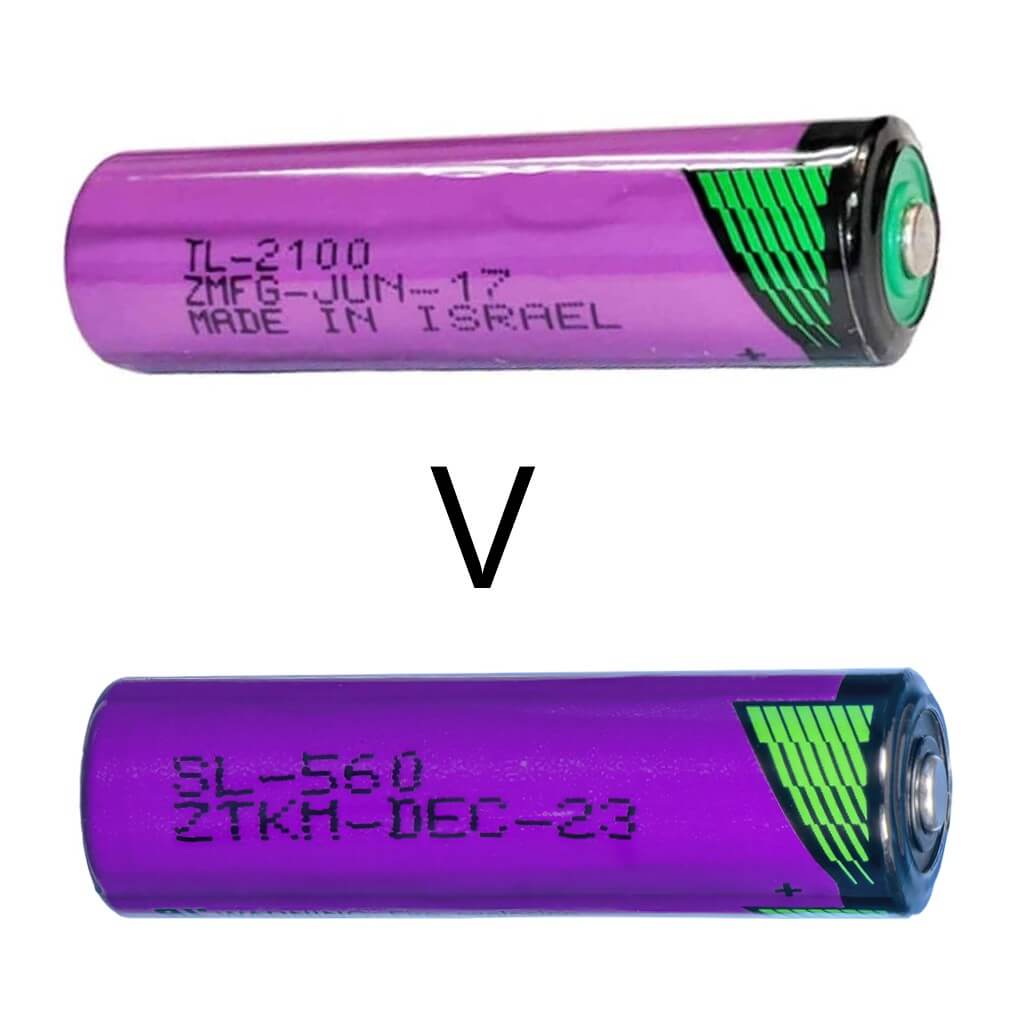Below is a comprehensive technical comparison of the Tadiran SL-560 and TL-2100 AA lithium batteries based on the provided specifications:
- Chemistry and Voltage
- SL-560:
- System: Lithium Thionyl Chloride (Li-SOCl₂)
- Nominal Voltage: 3.6 V
- TL-2100:
- System: Lithium Thionyl Chloride (Li-SOCl₂)
- Nominal Voltage: 3.6 V
Observation: Both batteries use the same chemistry and have an identical nominal voltage of 3.6 V.
- Capacity
- SL-560:
- Nominal Capacity: 1.8 Ah
- TL-2100:
- Nominal Capacity @ 2 mA, to 2V: 2.1 Ah
Observation: The TL-2100 has a 16.7% higher capacity than the SL-560, making it preferable for applications requiring longer battery life at moderate discharge currents.
- Discharge Performance
Current and Voltage Characteristics
- SL-560:
- Supports currents from 0.02 mA to 20 mA.
- Voltage remains stable (~3.6 V) over a wide range of currents, but drops slightly at higher discharge rates.
- Typical discharge current values and corresponding capacities:
- 20 mA (60 Ω): ~1.4 Ah
- 2 mA (1.8 kΩ): ~1.8 Ah
- 0.06 mA (56 kΩ): ~1.4 Ah
- TL-2100:
- Provides detailed discharge characteristics:
- 16 mA (200 Ω): ~1.6 Ah
- 2 mA (1.8 kΩ): ~2.1 Ah
- 20 μA (180 kΩ): ~1.6 Ah
Observation: The TL-2100 shows better capacity retention at lower discharge currents (e.g., 2 mA) and a higher total capacity for lower current applications.
- Maximum Current Handling
- SL-560:
- Max Continuous Discharge Current: 100 mA
- Pulse Current Capability: 200 mA
- TL-2100:
- Max Continuous Discharge Current: 120 mA
- Pulse Current Capability: 200 mA
Observation: The TL-2100 supports a slightly higher continuous discharge current (120 mA vs. 100 mA), making it better for devices with higher power requirements over sustained periods.
- Operating Temperature Range
- SL-560:
- Range: −55 °C to +130 °C
- TL-2100:
- Range: −55 °C to +85 °C
Observation: The SL-560 has a significantly broader temperature range, especially for high-temperature environments up to +130 °C, compared to +85 °C for the TL-2100.
- Weight and Volume
- SL-560:
- Weight: 18 g
- Volume: 8 cm³
- TL-2100:
- Weight: 17.6 g
- Volume: 8 cm³
Observation: Both batteries are similar in weight and volume, with the TL-2100 being slightly lighter.
- Safety and Certifications
- SL-560:
- No specific certifications mentioned.
- TL-2100:
- U.L. Component Recognition: MH 12193
Observation: The TL-2100's UL certification ensures compliance with safety standards, which may be necessary for regulated applications.
- Available Terminations
- SL-560:
- Available with standard terminals, tags, pins, radial pins, and polarized tags.
- TL-2100:
- Similar options: standard, solder tabs, axial pins, radial pins, and polarized tabs.
Observation: Both batteries offer a wide range of termination options, ensuring compatibility with various device designs.
- Applications
- SL-560:
- Designed for extreme environments, especially high temperatures and industrial applications.
- TL-2100:
- Designed for devices requiring higher energy density, better discharge characteristics at low currents, and compliance with safety certifications.
Key Takeaways
- Capacity: The TL-2100 has a higher nominal capacity, especially suitable for low-current applications.
- Temperature Tolerance: The SL-560 has a much wider operating temperature range, making it ideal for high-temperature or extreme conditions.
- Current Handling: The TL-2100 supports a slightly higher continuous discharge current.
- Safety: The TL-2100 has UL certification, making it a better choice for safety-critical and regulated applications.
- Weight: The TL-2100 is marginally lighter.
Recommendation
- Use the SL-560 for applications that have high temperatures or where thermal stability is required at the top end of its temperature range.
- Opt for the TL-2100 for general-purpose applications requiring higher capacity, better discharge characteristics at low currents, or regulatory compliance.

